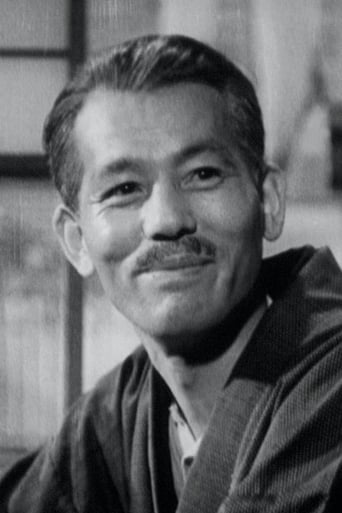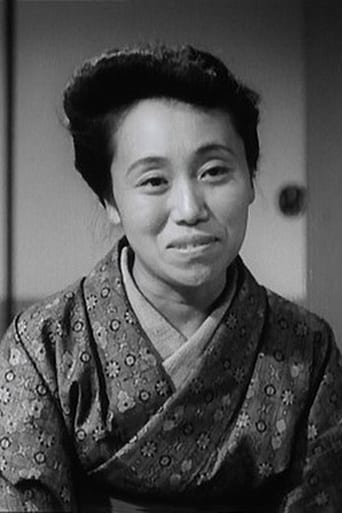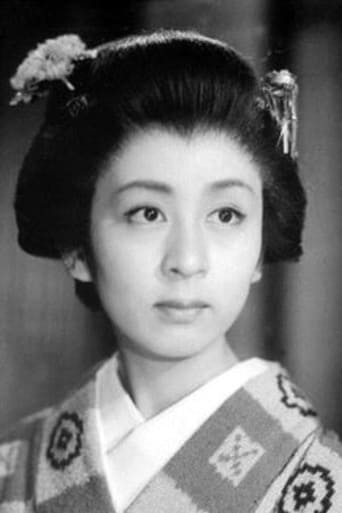BootDigest
Such a frustrating disappointment
ReaderKenka
Let's be realistic.
BallWubba
Wow! What a bizarre film! Unfortunately the few funny moments there were were quite overshadowed by it's completely weird and random vibe throughout.
Derrick Gibbons
An old-fashioned movie made with new-fashioned finesse.
WILLIAM FLANIGAN
YOU WERE LIKE A WILD CHRYSANTHEMUM / SHE WAS LIKE A WILD CHRYSANTHEMUM / MY FIRST LOVE AFFAIR (NOGIKU NO GOTOKI KIMI NARIKI). Viewed on Streaming. Set design = seven (7) stars; costumes = six (6) stars; cinematography = six (6) stars; music = six (6) stars; restoration = four (4) stars; matting/masking = one (1) star. Director Keisuke Kinoshita (who is also credited as the script writer) presents his take on the oft-told tale about one's first crush as a teenager remaining a memory that lasts forever--especially if it was unconsummated (and in this case also forbidden). His photo-play consists mostly of flashbacks which are hard to see (and contravene some fine cinematography--see below) due to an ever-present superimposed white framing matte that shrinks the already small screen format by about a third more. Masking combined with the many long and medium shots that comprise the film confronts the viewer with a challenge somewhat like trying to discern what's going on by viewing the movie backward through a telescope! Kinoshita seems to believe that the idyllic life of teenagers from the late 19th century was one of mostly running and strolling together through the landscape as well as helping to harvest family crops now and then. Perhaps this was not boring for kids back then (or the Director is simply being naive), but it sure is hard to swallow and flat-out boring for today's viewers. Acting is uneven (perhaps due to a combination of miscasting and inadequate direction?). Actress Noriko Arita plays one of the two teenage protagonists and easily steals every scene she is in while upstaging and all but obliterating actor Shinji Tanaka's weak performance as the other teenager. The latter is clearly out of his acting depths! Distinguished (and prolific) character actor Chishuu Ryuu bookends the proceedings by providing excessive narrative as a reminiscing senior citizen. His considerable talent seems wasted in this production. Performances by other character actresses and actors range from okay to forgettable. Scenes of all-women family "war councils" arguably provide the best ensemble acting. Set designs/locations add much as do costumes and music. The later mostly consists of solitary string instruments playing imaginative compositions. Cinematography (narrow screen, black and white) includes some fine tracking and panoramic shots. The former are often all but invisible due to masking while the latter "cry out" for a wide screen format (and masking removal)! Subtitles are close enough. Not all signs are translated. Video restoration is okay. Not so much for the sound track. Hiss and other noise due to deterioration are heard through out the film. Camera racket (or someone running a cement mixer in the background!) is often present. Not especially recommended. WILLIAM FLANIGAN, PhD.
toshiko-946-519300
This film is based on Sachio Ito's novel titled "Nogiku no Haka" literally meaning "The Grave in a Daisy Flower Bed." The novel starts with a thirty-something Masao's monologue in which he decides to write down what happened to him and Tamiko when he was young. He says he cannot stop thinking of those happy and sad days over and over again. Masao remembers that Tamiko was pressured by the family and relatives to accept a marriage offer and died not long after she got married. Masao is married now through a similar marriage arrangement. At the end of the novel, Masao recalls the day when he visited the home of Tamiko's parents soon after her death. Masao was told that Tamiko was holding his photograph and a letter in her hand when she was found dead. It was the letter he gave her just before he left home to start a new school life. Masao and Tamiko's family visited her grave together and he saw her graveyard surrounded by full of daisies. He planted more daisies around. He admits his lasting emotion of love. In the film version, Kinoshita, the director, extends the original story by portraying Masao as an aged man of 73 years old. The elderly gentleman is on a dingy being rowed against the stream on his way to Tamiko's grave. The creation of an old Masao was an excellent cinematic achievement by the master director, who was able to enhance an incidental and passing emotion felt between two people in their youth into an eternal life-long love that is profoundly touching the emotions of the audience of all ages. "My First Love Affair" was chosen for the title of this film but it seems to miss the point that the director may have wished to make in the film. "My Love" or "My Only Love" may ring better as the title of this masterpiece. Kinoshita chose a title "Nogiku no Gotoki Kimi nariki", literally meaning "You were like a daisy in the field".
souvikmeetszeus
By now, I have almost turned stoic under the stream of excellent films, but this was a magical one! At once a mesmerizing ode to the emotion of 'love', a subtle critique on the Japanese society of the time and a thing of gorgeous beauty in every frame, this movie is a really fulfilling one. It is rich in emotional intensity, in the typically subdued manner that fits Japan, yet reaching out and effecting you. The story is of a girl and a boy who fall in love and all that ensues around them, including pressures from family, society, demands of life, etc. and with a denouement that is heartrending, to say the least. The camera drenched in mood is amazing, and the soundtrack at places is really marvelous, beautifully supplementing the film's sombre tone. Kinoshita brings romance into perspective, putting stress on the journey and not the results, and this along with Dvoje has to be two of the most complete explorations of 'love' I have seen. At minor phases, the movie might be a little stagnant or melodramatic but otherwise, its entire body sparkles with technical brilliance and innocent poignancy. Contrasted with the social behaviors that other character's exhibit, Masao and Tamiko's saga assumes an aura of purity, and ironically, also of a battle. All of the movie is narrated through the memories of an old man who returns to his home land, and the effect used on the film actually gives us a feeling that we are taking a trip down somebody's inner mind; and this is just another example of the well done technical aspects that come together to serve up a stirring, deep and 'cinematographic-ally' magnificent tale of transcendental romance. The last few moments and lines are lovely to experience, sure to touch everybody at some place.
sharptongue
The style of this film manages to be at once naturalistic, sentimental, and at times highly dramatic. The minutiae of daily life in a village makes the settings very real indeed. Harvesting and threshing rice, picking "egg-apples" and cotton in the mountains, gossiping over dinner.The boy and girl, whose childhood innocence but very strong friendship seamlessly turns into more adult love (though thoroughly chaste), are mercilessly taunted by nearly everyone close to them. The impression is of a relationship developing under total and minute scrutiny. This sort of thing can happen anywhere, particularly in a small village, but in a Japanese village, the atmosphere for the young couple is beyond claustrophobic, even when they are in the wide open spaces.The tone of the story is, and is enhanced by the generally restrained performances, highly emotional, sometimes veering towards melodrama. Though I would be hard pressed to describe this story as a romance, I can well imagine some viewers being moved to tears by the unfairness and injustice of it all.The story was rather too simple for my liking, though this could be unfair, because I am comparing it to masterworks by the same director, such as Happiness For Us Alone. Nevertheless, the story becomes powerful and effecting towards the end, and is difficult to forget.



